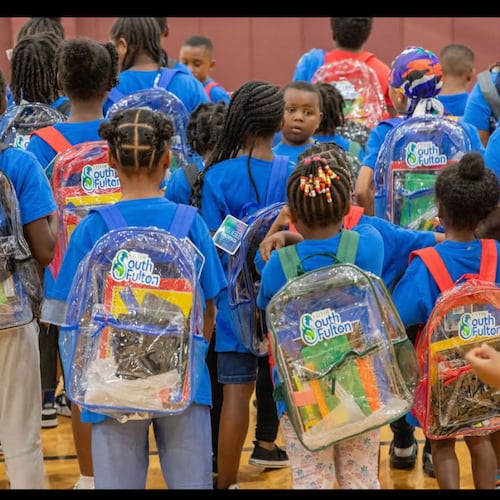School leaders across Georgia say new state guidelines for reopening schools will help them plan for the fall, but the guidance makes clear that each district will make its own decision for when and how students return to class.
The recommendations in the 10-page document, "Georgia's Path to Recovery for K-12 Schools," were written by the state education and public health departments. The document, released Monday, is the first official statewide advisory for educators responsible for Georgia's nearly 2 million K-12 public school students next school year.
It offers a range of options that allow local officials to react to changing local conditions, from the low to the substantial spread of COVID-19.
It is a helpful resource, said Steve Smith, superintendent of the Bleckley County School District south of Macon, but he said it is missing one thing he needs to know: “What constitutes a major outbreak and a what constitutes a medium outbreak?”
The state’s 180 school districts operate independently under the Georgia Constitution and, absent an emergency mandate from Gov. Brian Kemp, will decide whether and how to open their buildings this fall — and when to close them — should conditions warrant.
That is why the new guidance is not mandatory. School superintendents will have to tap local and state health officials to help determine their relative coronavirus risk. The virus will spread at different rates in different regions, said Matt Jones, chief of staff for state schools Superintendent Richard Woods.
"What could work in one county might not work in another," he said, adding that state health officials are expected to develop more clarity around how to determine local conditions. Also, a 72-member state panel is expected to elaborate on the parts of the guidance that raise a lot of questions.
Metro Atlanta school leaders say the guidance is helpful and they appreciate that it leaves them with the authority to make plans based on local conditions. Among the options Fulton County is considering, for instance, are hybrid models recommended in the guidance, and the district has numerous staffers serving on the state working groups that will be elaborating on the guidance.
“Ultimately, we’re going to have to make a decision for ourselves about what the school district is going to do,” Decatur Superintendent David Dude said. “The guidance will be a piece of that.”
The options
The core of the document is a decision tree of possible actions with options for fall and the rest of the school year ranging from slightly modified traditional schooling in the best case, to closed buildings, like this past spring semester, in the worst.
In the middle are a variety of options, including so-called “hybrid” models that maximize social distancing by minimizing the number of students in buildings at one time. Those models include allowing groups of students to attend on alternating days or weeks, as well as allowing only younger students to attend while older students learn at home.
Those could be so tricky to implement that the state is recommending them only “if absolutely necessary.”
Calhoun City School prefers the alternating weeks option.
“We felt every other day would be a huge challenge with parents and child care and transportation,” said Michele Taylor, superintendent of the school district along Interstate 75, between Atlanta and Tennessee. Taylor would also like more clarity from health officials about how to categorize her local risk. She will seek advice from a local coronavirus task force of health, public safety, emergency management and other officials and community leaders.
Districts that find the hybrid option logistics too challenging could still hold classes in person. Advice for them includes keeping students’ desks away from teachers; using gyms, auditoriums and other large spaces where possible; staggering bell schedules to cut down on hallway congestion; and holding classes outdoors if the weather cooperates.
Careful planning could be undermined by any COVID-19 cases in the schools. The guidance recommends closing areas where an infected person has been, and keeping them closed for 24 hours before cleaning and disinfection, which would temporarily reduce capacity.
In even the best scenario, school would not look normal. The state is recommending that hallways be divided into travel lanes to minimize mixing, that schools help health officials with contact tracing and “specimen collection” and that signs be placed throughout buildings advising about hygiene and other safety protocols, such as staying home if sick.
Read the full report:
>>Sleep during a pandemic: Has bed time and wake-up time shifted dramatically for your kids (and for you) during COVID-19? Are you concerned about long-term consequences and wondering what to do? Let us know at CoronavirusEducation@ajc.com
Sarah Nataupsky, a mother in Forsyth County, said that for her, the need to educate her boys, aged 7 and 9, outweighs the health risks.
“I’m desperate. I will do whatever they ask,” she said. “At that age, they need the classroom. They need the teacher.”
She doubts they could wear masks all day, after watching one of them struggle with one at the dentist last month, but the online schooling last semester was, for her, “a nightmare.”
Both teachers and families should be given the option to work or study at home, the guidance says, with lawyers and human resources personnel guiding decisions about alternative assignments for teachers.
School leaders may find that some parents are too scared to send their kids to school, which means schools might have to invest more in online learning. Taylor said an ongoing survey in Calhoun that started last week shows as many as 30% are anxious about it.
And if schools opt for one of the hybrid options, they could be running and disinfecting their buses constantly to accommodate the multiple schedules and social distancing between students.
“It’s a practical impossibility to social distance on buses and make that a financially-efficient operation,” said John Zauner, executive director of the Georgia School Superintendents Association.
The constant disinfection, the masks, the bus fuel, the technology, the bottled water (water fountains should be disabled in areas with moderate coronavirus spread) the extra staffing, (more nurses should be employed in areas with substantial spread) would all cost money, some school leaders said. Meanwhile, the state is considering about $1.5 billion in education funding cuts.
Schools can use various “hybrid” attendance models if the local spread of COVID-19 is minimal or moderate
- A/B Alternating Days — schools would divide enrollment in half and send one group into the buildings on Mondays and Wednesdays, the other on Tuesdays and Thursdays, with students studying at home on Fridays
- A/B Alternating Weeks —half the students attend one week and half the next
- A/B Half Days — half the students attend in the mornings each day and the other half in the afternoons
- Age Targeted — high school and maybe middle school students stay home while younger students occupy the buildings
School will not look normal even with low to minimal spread of COVID-19. Here’s what students might see:
- Inoperative water fountains replaced with bottled water
- Bus drivers wearing masks
- Spread out seating on buses and in classrooms
- Routine screening for illness when boarding buses or entering buildings
- Marks on the floor in cafeterias and other queuing areas indicating safe spacing
- Staggered bell schedules to reduce hallway congestion
- Outdoor classrooms when weather permits
- Closed pairings of students and teachers, with minimal mixing between groups
About the Author
Keep Reading
The Latest
Featured


